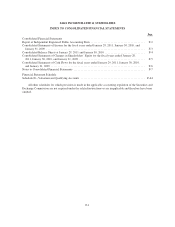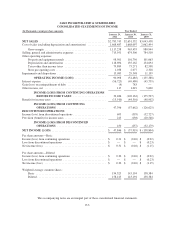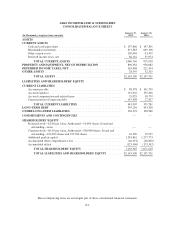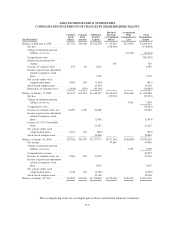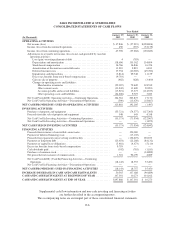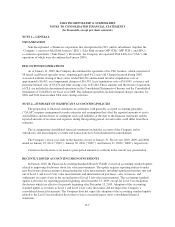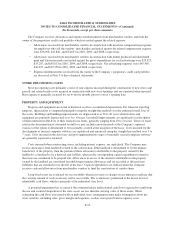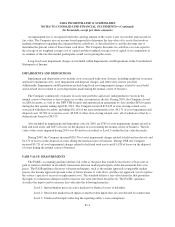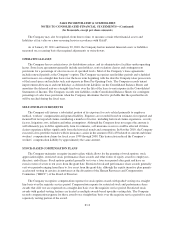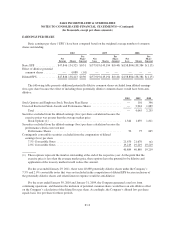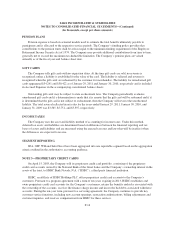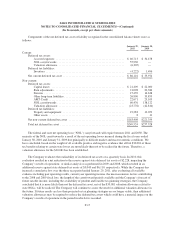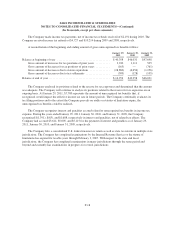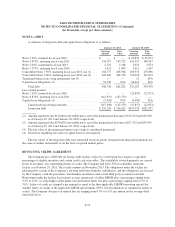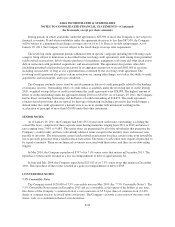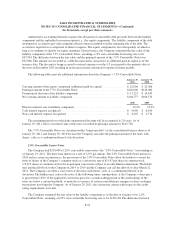Saks Fifth Avenue 2010 Annual Report Download - page 61
Download and view the complete annual report
Please find page 61 of the 2010 Saks Fifth Avenue annual report below. You can navigate through the pages in the report by either clicking on the pages listed below, or by using the keyword search tool below to find specific information within the annual report.SAKS INCORPORATED & SUBSIDIARIES
NOTES TO CONSOLIDATED FINANCIAL STATEMENTS—(Continued)
(In thousands, except per share amounts)
An impairment loss is recognized when the carrying amount of the assets is not recoverable and exceeds its
fair value. The Company uses an income-based approach to determine the fair value of its assets that involves
making assumptions regarding the estimated future cash flows, as described above, and the discount rate to
determine the present value of those future cash flows. The Company discounts its cash flows at a rate equal to
the average of its weighted average cost of capital and the weighted average cost of capital of its competitors as
an estimate of the rate that market participants would use in pricing the assets.
Long-lived asset impairment charges are included within Impairments and Dispositions in the Consolidated
Statements of Income.
IMPAIRMENTS AND DISPOSITIONS
Impairment and disposition costs include costs associated with store closures, including employee severance
and lease termination costs, asset impairment and disposal charges, and other store closure activities.
Additionally, Impairments and Dispositions include long-lived asset impairment charges related to assets held
and used and losses related to asset dispositions made during the normal course of business.
The Company continuously evaluates its real estate portfolio and closes underproductive stores in the
normal course of business as leases expire or as other circumstances dictate. During 2010, the Company closed
six SFA locations, as well as one OFF 5TH location and announced an agreement to close another SFA location
during the first quarter ending April 30, 2011. The Company incurred $12,045 of store closing-related costs
associated with these locations, including $10,110 of net lease termination costs, $4,171 of asset impairment and
disposal costs, $2,504 of severance costs, $3,833 of other store-closing related costs, all of which are offset by a
deferred rent benefit of $8,573.
Also included in impairment and disposition costs for 2010 are $785 of asset impairment charges related to
held and used assets and $255 of losses on the disposal of assets during the normal course of business. The fair
value of the assets impaired during 2010 was $0 and was classified as Level 3 within the fair value hierarchy.
During 2009, the Company incurred $28,176 of asset impairment charges related to held and used assets and
$1,172 of losses on the disposal of assets during the normal course of business. During 2008, the Company
incurred $9,711 of asset impairment charges related to held and used assets and $1,428 of losses on the disposal
of assets during the normal course of business.
FAIR VALUE MEASUREMENTS
The FASB’s accounting guidance defines fair value as the price that would be received to sell an asset or
paid to transfer a liability in an orderly transaction between market participants at the measurement date (exit
price). The FASB guidance discusses valuation techniques, such as the market approach (comparable market
prices), the income approach (present value of future income or cash flow), and the cost approach (cost to replace
the service capacity of an asset or replacement cost). The standard utilizes a fair value hierarchy that prioritizes
the inputs to valuation techniques used to measure fair value into three broad levels. The FASB’s guidance
classifies the inputs used to measure fair value into the following hierarchy:
Level 1: Quoted market prices in active markets for identical assets or liabilities
Level 2: Observable market-based inputs or unobservable inputs that are corroborated by market data
Level 3: Unobservable inputs reflecting the reporting entity’s own assumptions
F-11


